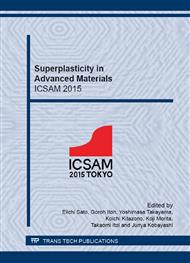[1]
M.A. Kumar, A.K. Kanjarla, S.R. Niezgoda, R.A. Lebensohn, C.N. Tome, Numerical study of the stress state of a deformation twin in magnesium, Acta Mater. 84 (2015) 349-358.
DOI: 10.1016/j.actamat.2014.10.048
Google Scholar
[2]
R. Korla, A.H. Chokshi, Strain-rate sensitivity and microstructural evolution in a Mg–Al–Zn alloy, Scr. Mater. 63 (2010) 913-916.
DOI: 10.1016/j.scriptamat.2010.06.047
Google Scholar
[3]
H. Conrad, L. Hays, G. Schoeck, H. Wiedersich, On the rate-controlling mechanism for plastic flow of Mg crystals at low temperatures, Acta Metall. 9 (1961) 367-378.
DOI: 10.1016/0001-6160(61)90230-9
Google Scholar
[4]
A.G. Evans, R.D. Rawlings, The thermally activated deformation of crystalline materials, phys. stat. sol. 34 (1969) 9-31.
DOI: 10.1002/pssb.19690340102
Google Scholar
[5]
H. Somekawa, K. Hirai, H. Watanabe, Y. Takigawa, K. Higashi, Dislocation creep behavior in Mg–Al–Zn alloys, Mater. Sci. Eng. A. 407 (2005) 53-61.
DOI: 10.1016/j.msea.2005.06.059
Google Scholar
[6]
H. Conrad, S. Frederick, The effect of temperature and strain rate on the flow stress of iron, Acta Metall. 10 (1962) 1013-1020.
DOI: 10.1016/0001-6160(62)90070-6
Google Scholar
[7]
R.J. Arsenault, The double-kink model for low-temperature deformation of B.C.C. metals and solid solutions, Acta Metall. 15 (1967) 501-511.
DOI: 10.1016/0001-6160(67)90083-1
Google Scholar
[8]
A. Segger, On the theory of the low-temperature internal friction peak observed in metals, Phil. Mag. 1 (1956) 651-662.
Google Scholar
[9]
T. Neeraj, D. -H. Hou, G.S. Daehn, M.J. Mills, Phenomenological and microstructural analysis of room temperature creep in titanium alloys, Acta Mater. 48 (2000) 1225-1238.
DOI: 10.1016/s1359-6454(99)00426-7
Google Scholar
[10]
T. Matsunaga, T. Kameyama, K. Takahashi, E. Sato, Intragranular deformation mechanisms during ambient-temperature creep in hexagonal close-packed metals, Trans. JIM. 50 (2009) 2865-2872.
DOI: 10.2320/matertrans.m2009224
Google Scholar
[11]
T. Matsunaga, H. Somekawa, H. Hongo, M. Tabuchi, Submitted.
Google Scholar
[12]
P.D. Wu, X.Q. Guo, H. Qiao, D.J. Lloyd, A constitutive model of twin nucleation, propagation and growth in magnesium crystal, Mater. Sci. Eng. A. 625 (2015) 140-145.
DOI: 10.1016/j.msea.2014.11.096
Google Scholar
[13]
R.Z. Valiev, O.A. Kaibyshev, Mechanism of Superplastic Deformation in a Mgnesium Alloy II. The Role of Grain Boundaries, phys. stat. sol. (a). 44 (1977) 477-484.
DOI: 10.1002/pssa.2210440209
Google Scholar
[14]
J. Koike, R. Ohyama, T. Kobayashi, M. Suzuki, K. Maruyama, Grain-boundary sliding in AZ31 magnesium alloys at room temperature to 523 K, Mater. Trans. 44 (2003) 445-451.
DOI: 10.2320/matertrans.44.445
Google Scholar
[15]
T. Matsunaga, E. Sato, Estimation of Grain Boundary Sliding During Ambient-Temperature Creep in Hexagonal Close-Packed Metals Using Atomic Force Microscope, in: V. Nalladega (Eds. ), Scanning Probe Microscopy-Physical Property Characterization at Nanoscale, InTech, Croatia, 2012, pp.203-214.
DOI: 10.5772/35640
Google Scholar


